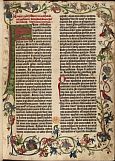The priceless Gutenberg Bible
An educational and informational site about rare, old and antiquarian books.
The priceless Gutenberg Bible

While the most common book ever to be published is the Bible, Bibles from the 1600s and earlier are actually considered quite scarce. They belong in a very elite group that is sought after by very wealthy collectors who are increasingly and unflinchingly pouring large sums of money into liturgical texts. It is a group which is akin to the French Riviera coastline real estate – there is a very finite quantity of it. One such Book that stands above all else is the Latin Gutenberg Bible, which was printed by Johann Gutenberg & Fust in Mainz in 1455.
According to the Gutenberg Museum, a mere 49 known copies of the Gutenberg Bible, less than half of which are complete copies, exist today. These 49 copies are only a small collection out of a possible 150 copies which were originally printed (120 on paper, 30 on vellum, parchment). Four additional copies have been discovered of the 45 known copies originally counted for in 1950, totaling the 49 copies which we are now aware of. The few complete Books, however, are not regarded as priceless today in the sense of marketable value, as there are currently no copies available for sale. In fact, all of the 21 known complete copies are restrictively owned by prestigious institutions, and have been deemed priceless in the sense that they will not be sold at any immediate time. On the rare occasion that one of these copies is sold, however, they are sold for astronomical amounts. Indeed, the last complete copy to be traded in 1987 was sold for an unabashed $5.4 million. Further records of sale for both whole copies and portions of copies through the decades are listed below:
2007 – A single leaf offered for sale; an A. Edward Newton “Noble Leaf” offering, with Doheny family provenance, exceeded $74,000.00.
1999 – At auction a single leaf sold for $26,000.
1998 – At auction four leaves sold $85,000-the equivalent of 21,250 per page.
1995 – A single leaf containing the Ten Commandments (Exodus, 20:1-17) went to a private party for $75,000.00.
1987 – A complete copy netted around $5.4 million.
1978 – $2.2 million paid for a two-volume Gutenberg.
1926 – In March, eight leaves (the entire Saint Paul Epistle to the Romans) of a Gutenberg from the library of Mrs. Hannah M. Standish were sold at public auction in New York for $1,750. That was the equivalent of $218 per page.
1847 – First Gutenberg Bible brought to the North American continent by the American book collector and philanthropist James Lenox; cost: $2,500; now in the New York Public Library.
The importance of this Bible is primarily attributed to the printing master work of Johann Gutenberg, and the gradual shift in his style of printing. The very first pages Gutenberg printed had only 40 lines per column. Later in the course of printing, Gutenberg realized the paper could accommodate 42 lines, so the pages were then reset and printed again in the improved format. The scarce original pages of 40 lines were included in the very first issue of the Gutenberg Bible. Another attractive aspect of Gutenberg’s biblical publications is his very liberal use of ornamentation and decorative symbolism on the pages of his Bibles. Where one may automatically assume that the original fifteenth century versions of the Bible were as dry and solemn as the chanting monks were perceived to be, Gutenberg’s publications are alive with vibrant colored flowers, vines, birds, creatures, and masterful calligraphy.
It is interesting to keep in mind that out of 150 copies to have originally been published, only 49 are currently recognized and brought to our awareness. Where, I wonder, could these remaining copies be in the world, and are most of them destroyed and unintelligible, or are there still, in fact, whole and intact copies buried in the farthest corners of the world, and hidden amongst the innermost shadows of forgotten rooms? Indeed, one may never know if perhaps one of these mysterious lost copies could be stumbled upon in the forsaken attics of our Italian nonas and papas, along with their once beloved wooden spoons and pasta recipes!


<< Home